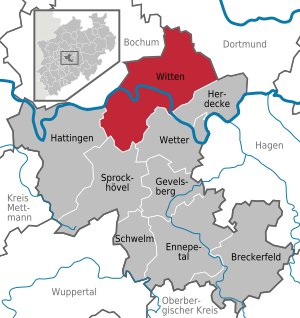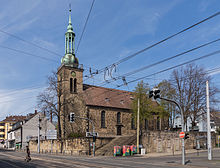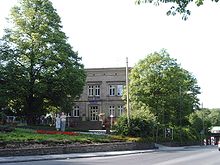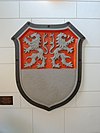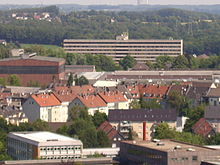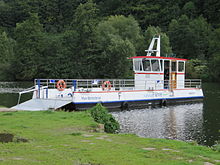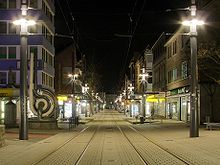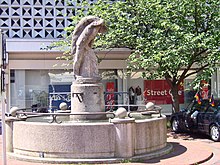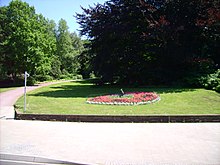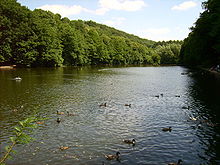Witten
| coat of arms | Germany map | |
|---|---|---|

|
Coordinates: 51 ° 26 ' N , 7 ° 20' E |
|
| Basic data | ||
| State : | North Rhine-Westphalia | |
| Administrative region : | Arnsberg | |
| County : | Ennepe-Ruhr district | |
| Height : | 104 m above sea level NHN | |
| Area : | 72.4 km 2 | |
| Residents: | 96,459 (Dec. 31, 2019) | |
| Population density : | 1332 inhabitants per km 2 | |
| Postcodes : | 58452-58456 | |
| Primaries : | 02302, 02324 | |
| License plate : | EN, WIT | |
| Community key : | 05 9 54 036 | |
| LOCODE : | DE WTT | |
| City structure: | 7 districts | |
City administration address : |
Marktstrasse 16 58452 Witten, Germany |
|
| Website : | ||
| Mayoress : | Sonja Leidemann ( SPD ) | |
| Location of the city of Witten in the Ennepe-Ruhr district | ||
The city of Witten is located in the southeast of the Ruhr area in the state of North Rhine-Westphalia and is a large city in the Ennepe-Ruhr district in the administrative district of Arnsberg .
Until 1974 Witten was an independent city . In the course of the reorganization in 1975, it was incorporated into the Ennepe-Ruhr district, whose largest city it is today. At the same time it achieved the status of a major city , which it maintained until the beginning of 2007.
geography
Witten is located at the transition from the lower Sauerland to the Niederbergischen hill country in the west and the Emscherland in the north, between the cities of Dortmund, Bochum and Hagen, at the northern exit of the narrow deep Ruhr breakthrough through the forest-covered Ardey sandstone plateau on both sides of the Ruhr river . The river valley with the dammed lake Kemnader shapes the image of the city next to the wooded hills of the Ardey Mountains , which are part of the Rhenish Slate Mountains . The mountain ranges consist mainly of sandstone , plus coal-bearing layers that are exposed in some places and that can be viewed on the Muttental mining trail .
The measuring point for the geographical location of the city of Witten is the spire of the Marienkirche. The highest point in the city is the Arenberg and measures 269 m, the lowest is on Wittener Straße, east of Blankenstein train station and is 71 m above sea level. NN . The city limits are 52 km long. The largest expansion of the urban area is 13.8 km in north-south direction and 10.5 km in west-east direction.
Neighboring communities
The following cities and communities border the city of Witten. They are called clockwise , starting in the northeast:
Dortmund (independent city), Herdecke , Wetter (Ruhr) , Sprockhövel and Hattingen (all Ennepe-Ruhr district) and Bochum (independent city)
City structure
The urban area of Wittens is divided into seven districts . These are further divided into several city districts.
|
|
|
climate
With an annual average of 750 mm, the amount of precipitation is significantly lower than in the surrounding low mountain ranges. Most of the rain falls in the summer period (July an average of 80–90 mm), the least in the winter period (February an average of 40–50 mm). The winters are relatively mild (January 3.1 ° C on average), the summers with an average temperature of around 18.6 ° C in August, relatively warm by German standards. The mean annual temperature is 9–10 ° C.
natural reserve
There are four nature reserves in the urban area . One around the Elbsche stream ( NSG Elbschebach Witten Bommerholz ), an area around the former Hardenstein Castle ( NSG Hardenstein ), the Kermelbach and the Ruhraue near Gedern . A total of around 184 hectares are protected.
history
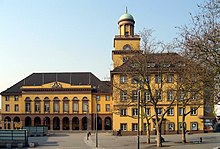
The oldest mention of the Herbede district (incorporated since 1975) goes back to the year 851. Witten itself was first mentioned in a document in 1214, but it is assumed that a chapel was built in the 9th century on the site where the Johanniskirche stands today in the heart of the city. The two Ruhr mills were first mentioned in 1321. The earliest mentions of the Witten coal - mining dating from 1552 and the 1578th
April 22nd / 2. May 1675 received Witten in Kleve the market law by the Elector Friedrich Wilhelm of Brandenburg . According to the document brought by the government, judiciary and court judge Mordio von der Reck , Thursday was set as market day. In addition, the expansion of the destroyed Ruhr bridge to Bommern was made a condition. In 1776 the Ruhr was made navigable in Witten, four years before the entire Ruhr was made navigable on the initiative of Friedrich II .
Until 1806 Witten belonged to the Grafschaft Mark , which later became Prussian through the House of Brandenburg, and from 1807 to 1813 to the Ruhr department of the Grand Duchy of Berg , under which the Mairie Witten was founded in 1809 . Subsequently, Witten temporarily belonged to the Prussian governorate between the Weser and Rhine and from 1815 finally to Prussia ( province of Westphalia ). The place was assigned to the Bochum district . In addition to Witten, the mayor's office in Witten included the communities of Langendreer, Stockum, Düren, Somborn and Werne. In 1823 Witten received city rights , left the Bochum district in 1899 and became an independent city.
On November 28, 1906, a fire and two explosions struck the Roburit factory near the city limits of Annen . 41 people died in the disaster, and there was also damage in the area.
On July 1, 1921, the municipality of Heven and on August 1, 1929 the municipalities of Annen (with Rüdinghausen, which was incorporated on April 1, 1922), Stockum, Düren, parts of Bommern and parts of Langendreer (Krone) were incorporated. During the Second World War , Witten was the target of almost 100 very destructive air raids because of its industrial importance. Towards the end of the war, Walter Model , commander-in-chief of the German troops in the west, briefly had his headquarters in the village school in Heven. The entire urban area, especially the area around the Ruhr bridges, became the scene of a bitter defensive battle between US troops and Wehrmacht units, which, however, soon had to evacuate the place little by little.
As part of the latest North Rhine-Westphalian territorial reform , Witten had to give up its district freedom on January 1, 1975 and was incorporated into the Ennepe-Ruhr district. At the same time, Witten was enlarged by the incorporation of the city of Herbede. With this, the urban area of Witten reached its present size.
Since 1982 Witten has been a university town and location of the private University of Witten / Herdecke and since 2015 has been allowed to call itself “University town on the Ruhr”.
Religions

Christianity
Witten has belonged to the Archdiocese of Cologne since it was founded and was subordinate to the Archdeaconate of St. George's Foundation in Cologne .
In 1582 the population turned to the Reformation . After that, the city was a predominantly Protestant city for many centuries. The Evangelical Lutheran creed was predominant . With the transition to Prussia , the Protestant community in Witten also belonged to the Evangelical Church in Prussia or its Westphalian provincial church . She was assigned to the superintendent of Hattingen. Today this administrative unit is called Kirchenkreis Hattingen-Witten and includes the Protestant parishes of the cities of Hattingen, Witten, Sprockhövel, Velbert-Leberhof and Wetter-Wengern . The eight Protestant parishes in the city of Witten are Annen, Bommern, Trinitatis (with Christ Church, Heven and Oberkrone ), Herbede, Johanniskirche (inner city), Martin Luther Church, Rüdinghausen and Stockum. The institutional community of the Diakoniewerk Ruhr has meanwhile been assigned to the inner city (Johanniskirche).
As a reaction to the forced union between the Lutheran Church and the Reformed tradition to form the Evangelical Church in Prussia (from 1922 Evangelical Church of the Old Prussian Union ; APU), the Evangelical Lutheran (Old Lutheran) Church of Prussia was created. The Old Lutherans insisted on their religious freedom by demanding unreserved Lutheran worship, constitution and teaching. After a period of severe persecution by the state, it was constituted in 1841 under King Friedrich Wilhelm IV and was recognized. In 1896 the Evangelical Lutheran (Old Lutheran) Kreuzkirchengemeinde Witten was established in Witten. This parish today belongs to the Westphalia church district of the Independent Evangelical Lutheran Church . The superintendent of the parish of Westphalia of this Lutheran church is also located there.
The few Catholics in Witten after the Reformation still belonged to the Archdiocese of Cologne until 1821, then to the Diocese or Archdiocese of Paderborn . In 1834 the Catholics were able to found their own congregation again, which initially belonged to the Deanery Hattingen. In 1921 Witten became the seat of its own deanery, which today belongs to the Ruhr-Mark region of the Archdiocese of Paderborn. When the city of Herbede was incorporated in 1975, it retained its membership of the Essen diocese and is the only district of Witten to belong to a different diocese. Parishes in the city of Witten are St. Marien, St. Vinzenz, St. Joseph, St. Pius, St. Maximilian Kolbe, St. Franziskus von Assisi, Herz Jesu, St. Peter and Paul Herbede.
In 1954 the Carmelite Convent was built in Annen.
There are also various free churches , including Free Evangelical Congregations (the seat of the Federation of Free Evangelical Congregations in Germany is located here ) and an Evangelical Free Church Congregation ( Baptists ). The New Apostolic Church is also represented in Witten with two congregations (center, Annen).
Others
There are records of Jews in Witten since 1815 . The Jewish community pointed to the establishment of 1847 a steadily increasing trend with a maximum of more than 500 people. On March 20, 1885, the foundation stone of the synagogue was laid in Kurzen Strasse (today Synagogenstrasse). This was looted, set on fire and completely destroyed during the November pogroms in 1938 by citizens of Witten led by the National Socialist state terror. The Jewish citizens were robbed of their property by the state, forced to emigrate or murdered. The approx. 100 (as of 2012) Jews living in Witten belong to the Jewish community of Greater Dortmund , but some also attend events and services in the communities in Bochum and Hagen .
The four Islamic communities with mosques in Witten (Annen, Herbede, Breitestr. And Wideystr.) Were founded by Turkish and Bosnian guest workers at the end of the 20th century. Of these, two Turkish communities belong to the DİTİB (center and Herbede), one to Millî Görüş (Annen) and the Bosnian community to the IGBD (center).
Denomination statistics
According to the 2011 census , 39.3% (37,853) of the population in 2011 were predominantly Protestant , 24.8% (23,886) Roman Catholic and 35.9% (34,643) were non-denominational , belonged to another religious community or did not provide any information . The number of Protestants and Catholics has fallen since then. In 2013 there were around 22,000 Catholics in Witten. Currently (as of March 31, 2019) around 21% (21,000) of the residents are Catholic.
Population development
In the Middle Ages and at the beginning of the modern age, only a few hundred people lived in Witten. Due to numerous wars, epidemics and famine, the population rose only slowly. In the 19th century, with the onset of industrialization , Witten saw strong population growth. In 1808 only 1,587 people lived in the city, in 1900 there were already over 33,000.
In the course of the incorporation of Herbede (15,021 inhabitants 1974), the population of the city of Witten exceeded the limit of 100,000 on January 1, 1975, making it a major city . At the same time, the population reached its historical high of 109,554. Since the mid-1990s, this number has continuously decreased from around 105,000 in 1994, so that in 2007 Witten fell below the limit of 100,000 inhabitants and thus lost its status as a major city. On December 31, 2019, the official population of Witten was 96,459 (only main residences and after comparison with the other state offices).
politics
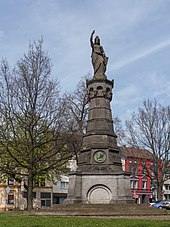
Up until the end of the 18th century, Witten's administration was in the hands of the patrimonial court lord, the owner of the Witten house . This structure was abolished in 1806 and in 1809 Witten received civil administration during the occupation of the region by French troops ( see also : Mairie Witten ). The mayor was then at the head of the city . After Witten received town charter in 1823, the revised town order was introduced in 1841 and the rural community order in 1842. In 1850 the Westphalian city order was introduced. After gaining district freedom, the mayor carried the title of Lord Mayor .
During the time of National Socialism , the mayor was appointed by the NSDAP . After the Second World War, the military government of the British occupation zone appointed a new Lord Mayor and in 1946 it introduced the local constitution based on the British model. Then there was a city council elected by the people , whose members are known as city councilors . The council initially elected the mayor from among its members as chairman and representative of the city, who was active on a voluntary basis. Furthermore, from 1946 the council also elected a full-time senior city director as head of the city administration. With the incorporation into the Ennepe-Ruhr district in 1975, the city leaders carried the title of mayor or city director. In 1999 the dual leadership in the city administration was given up. Since then, the full-time mayor has performed both functions in personal union.
City leaders
Mayor: 1809–1945 and since 1975; Lord Mayor: 1946–1975:
- 1809–1813: Zacharias Johann Friedrich Schmieding
- 1813–1825: Conrad Ludwig Clasen
- 1825–1839: Scourge
- 1839-1850: Kämper
- 1851–1856: Wichelhausen
- 1856–1869: Farmer
- 1869–1873: Friedrich Wilhelm Wegner
- 1873–1877: Geisenheimer (dismissed)
- 1877–1883: Haarmann, Brickenstein, Grieben, (substitute)
- 1883–1889: Bürkner, mayor
- 1890–1911: Gustav Haarmann , National Liberal Party
- 1911–1933: Otto Laue , German National People's Party
- 1933–1944: Erich Zintgraff
- 1944–1945: Karl August Wietfeldt
- 1945: Wilhelm Zimmermann
- 1945: Johannes Grimm
- 1945–1946: Alfred Junge, SPD
- 1946–1950: Albert Martmöller , SPD
- 1950–1952: Walter Rieckesmann
- 1952–1953: Albert Martmöller , SPD
- 1954–1967: Fritz Reincke, SPD
- 1967–1978: Friedhelm Ottlinger , SPD
- 1978–1983: Klaus Lohmann , SPD
- 1983: Arthur Raillon, SPD
- 1983–1989: Friedhelm Trepper, SPD
- 1989–2004: Klaus Lohmann , SPD
- 2004– : Sonja Leidemann , SPD
City directors or city directors
- 1946–1947: Alfred Junge, City Director
- 1947–1959: Ludwig Lehmann, City Director
- 1959–1982: Emil Dreidoppel , City Director
- 1982–1993: Reinhard Wiederhold , City Director
- 1993–1999: Gert Buhren , City Director
City Council
The council of the city of Witten usually has 50 seats. As a result of the election on May 25, 2014, it has grown to 72 seats in this electoral period through overhang seats. The seats are distributed as follows (in brackets the shares of the votes cast in the election):
- SPD 22 seats (35.2%)
- CDU 16 seats (23.5%)
- Alliance 90 / The Greens 9 seats (13.0%)
- Citizens' forum 7 seats (10.5%)
- The Left 4 seats (6.0%)
- Solidarity for Witten 3 seats
- 1 seat per NRW (2.8%)
- 1 seat per Germany
- WBG 2 seats (2.2%)
- FDP 2 seats (2.2%)
- Pirate Party 2 seats (2.1%)
- Witten Direkt 2 seats (1.2%)
- ON Witten 1 seat (1.2%)
At the beginning of June 2014, Andreas Günzel switched from the CDU to Witten Direkt, so that the CDU parliamentary group on the council reduced from 17 to 16 seats and Witten Direkt now also has parliamentary group status with two seats .
A city councilor originally drafted for Pro NRW joined Pro Deutschland in 2015.
Since March 1, 2016 there has been a three-person parliamentary group “Solidarity for Witten” in the Council, which was formed after splitting off from the SPD. Accordingly, the SPD parliamentary group only has 22 instead of the original 25 seats.
The Witten city associations of the SPD and CDU have concluded an alliance agreement on cooperation in the council. In doing so, they replaced the alliance between the SPD, Bündnis 90 / Die Grünen and WBG from the previous election period.
Local political groups in the city council
- WBG : The Witten Citizens' Community (WBG) was founded in 1999 as a community-oriented group of voters. Its predecessor organization was founded by some CDU members after an internal party leadership dispute. She made the leap to the council straight away in 1999 and opposed a takeover by Witten doctors in 2009.
- AUF Witten : The AUF Witten electoral group was founded on September 26, 2003 by members of the Marxist-Leninist Party of Germany , individual former members of the SPD and people who were not politically bound as a non-party electoral alliance.
- Citizens 'Forum : The Citizens' Forum first appeared in 2009. The list was initially founded as an association of several Witten doctors. An admission to the WBG and the filling of the first list places of the WBG for local elections did not succeed before. For this reason, the doctors founded the citizens' forum together with some former members of the WBG and made it straight to the council.
- Witten Direkt: took part in the 2014 local elections for the first time and achieved a seat on the city council with 1.2%. In first place on the nomination was a former council member of the Left Party , who had left the parliamentary group and the party after disputes.
Mandate holder of the city of Witten
German Bundestag, Berlin
- 1953–1965: Richard Oetzel , Member of the Bundestag (CDU) (state list)
- 1965–1969: Gustav Heinemann , Member of the Bundestag (SPD) (direct mandate)
- 1965–1976: Gerd Springorum , Member of the Bundestag (CDU) (state list)
- 1969–1983: Herbert Baack , Member of the Bundestag (SPD) (direct mandate)
- 1980–2002: Norbert Lammert , Member of the Bundestag (CDU) (state list)
- 1983–1998: Klaus Lohmann , Member of the Bundestag (SPD) (direct mandate)
- 1998–2013: Christel Humme , Member of the Bundestag (SPD) (direct mandate)
- 2002–2018: Ralf Brauksiepe , Member of the Bundestag (CDU) (state list)
- 2005–2009: Konrad Schily , Member of the Bundestag (FDP) (state list)
- 2013-today: Ralf Kapschack , Member of the Bundestag (SPD) (direct mandate)
State Parliament of North Rhine-Westphalia, Düsseldorf
- 1975–1980: Theodor Schwefer , Member of the Bundestag (CDU) (state list)
- 1990–2000: Laurenz Meyer , Member of the Bundestag (CDU) (state list)
- 1990–2005: Dietrich Kessel , MdL (SPD) (direct mandate)
- 2003–2005: Daniel Sodenkamp , Member of the Bundestag (FDP) (state list)
- 2005–2017: Thomas Stotko , Member of the Bundestag (SPD) (direct mandate)
- 2010 – today: Verena Schäffer , Member of the Bundestag (Greens) (state list)
- 2017-today: Nadja Büteführ , Member of the State Parliament (SPD) (direct mandate)
coat of arms
| Banner, coat of arms and flag | |

|

|

|
|
The coat of arms of the city of Witten shows two averted, double-tailed, silver lions on a shield divided by red and silver. The seal of the Everhards von Witten-Steinhausen from 1283 served as a template for the coat of arms. Originally, in addition to the lions, the Everhards' heraldic animal, their motto "Sigillum Hermanni de Wittene" was also shown.
A four-tower wall crown was placed on the badge in the form of a stylized triangular shield. It was first attached to a bowl (decorative bowl) that the mayor Rudolf Brickenstein received from the city of Witten in 1883 in recognition of his unpaid work. During a review of the Westphalian city arms in 1908, a revised draft was accepted and royal approval on November 6, 1911. The coat of arms now consisted of a three-towered sandstone-colored wall crown. The stylized rectangular shield was again divided in two into a lower silver and an upper red half, in which the two silver lions were depicted. The Latin transcription was no longer used.
The city coat of arms remained unchanged during National Socialism. Witten did not need to comply with the endeavors after the Second World War to remove warlike and National Socialist symbols from coats of arms. It could be credibly proven that the two lions do not assume an attack position, but a defensive position. On April 24, 1945, the English military government confirmed the Witten coat of arms, which has not undergone any fundamental changes to this day, but has only been redesigned according to graphic and heraldic aspects.
logo
The logo of the city of Witten from the 1970s - a black square in which a stylized "W" could be recognized by parallel oblique and vertical green-filled lines - was replaced in 2005.
The new logo - a curved line as "Witten-W" - can be interpreted as the course of the Ruhr. The brushstroke should symbolize cosmopolitanism and dynamism. The blue color stands for the water of the Ruhr and emphasizes the proximity of the city to the river, its historical lifeline. On the right above this line there is a filled circle, the color of which is intended to symbolize the urban center - the town hall painted in gold and yellow .
Town twinning
The city Witten talks to several cities twinning , some of which are animated by their own associations and groups of friends Wittener citizens.
- Beauvais (France), since 1975
- Mallnitz (Austria), since 1979
- Lev Hasharon (Israel), since 1979
- London Borough of Barking and Dagenham (Great Britain), since 1979
- Bitterfeld-Wolfen (Saxony-Anhalt), since 1990 (initially Wolfen , merged with Bitterfeld on July 1, 2007 )
- Kursk (Russia), since 1990
- Tczew (Poland), since 1990
- San Carlos (Nicaragua), friendship treaty since 1990
- Mek'ele (Ethiopia), since 2016
Independent sponsors and organizations
Witten is the seat of the Federation of Western Thrace Turks in Europe .
Schools, education
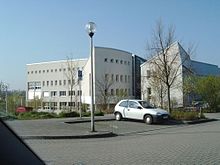
In Witten, primary school students are taught at seventeen different primary schools. In the area of secondary schools, there are two secondary schools, the Freiligrathschule and the Overbergschule, three secondary schools with the Adolf-Reichwein-Realschule , the Helene-Lohmann-Realschule and the Otto-Schott-Realschule, two comprehensive schools (Hardenstein-Gesamtschule, Holzkamp-Gesamtschule) and three grammar schools with the Albert-Martmöller-Gymnasium , the Ruhr-Gymnasium Witten and the Schiller-Gymnasium. In addition to these mainstream schools, there are two Waldorf schools (Rudolf Steiner School Witten, Blote Vogel School Annen) and two special needs schools (Pestalozzi School, Fighting School). There are also six vocational schools in Witten, the adult education center ( Witten-Wetter-Herdecke ), a municipal and several private music schools, the Institute for Waldorf Education and the University of Witten / Herdecke , which was founded in 1982 as the first private German university. Since 2016, the city has also been home to the Evangelical Pop Academy as the second university location of the University of Church Music of the Evangelical Church of Westphalia in Herford .
health
The city of Witten is home to two hospitals, the Catholic Marienhospital and the Evangelical Hospital Witten ( deaconess house until the mid-1970s , the name is still used colloquially today). The German Center for Neurodegenerative Diseases has had a location since 2009 .
Infrastructure and economy
traffic
Road traffic
In the late 18th century, the city was the road an important traffic connection Hagen-Witten Bochum-Steele. This newly laid road, which was developed for year-round traffic with heavy wagons, usually did not run right through today's inner cities; Witten was connected by the main road and the upper road. The road that branches off from the Chaussee at Crengeldanz in the direction of Dortmund has created a locally and regionally important transport hub. From 1803 a stagecoach route ran here from Essen via Bochum and Hamm to Unna. In 1808 another route followed from Bochum via Stockum and Brünninghausen to Hörde , which was temporarily suspended between 1813 and 1822. In 1823 a permanent post office was set up at Crengeldanz. On June 22, 1825, the post office followed. After another post office was set up in today's city center, traffic shifted away from Crengeldanz, so that in 1850 the post expedition that had been set up in the meantime had to close. At the instigation of the Crengeldanz glass factory and the Crengeldanz brewery , it was reopened in 1881 as the imperial post office, to which its own telegraph company was attached on June 1, 1882 . It was located in the building on Crengeldanzstrasse 92, which still exists today.
Witten is connected to the motorway network by the A 43 , A 448 and A 45 , with the Witten-Heven and Witten-Herbede junctions on the A 43 and the Witten-Zentrum, Witten-Stockum and Witten-Herbede junctions on the A 448. Annen and on the A 45 the Dortmund-Eichlinghofen junction.
Rail transport
The Wittener main station is located on the electrified DB Kursbuch route 427 of Hagen to Dortmund or Bochum ( railway lines to Dortmund and Bochum main station ). These were built in 1848 (Hagen-Witten-Dortmund) and 1862 (Witten-Bochum-Langendreer) by the Bergisch-Märkische Eisenbahn-Gesellschaft . Between Hagen-Vorhalle and Witten Hauptbahnhof there is a parallel freight train route on the other side of the Ruhr .
The following lines stop in Witten Hauptbahnhof :
| Surname | number | Train run |
|---|---|---|
| Wupper Express | RE 4 | Dortmund Hbf - Witten Hbf - Hagen Hbf - Wuppertal Hbf - Düsseldorf Hbf - Mönchengladbach Hbf - Aachen Hbf |
| Ruhr-Sieg-Express | RE 16 | Essen Hbf - Bochum Hbf - Witten Hbf - Hagen Hbf - Letmathe - Finnentrop - Siegen Hbf or Iserlohn (train is divided into Letmathe) |
| Ruhr-Lenne Railway | RB 40 | Essen Hbf - Bochum Hbf - Witten Hbf - Hagen Hbf |
| Rhine-Ruhr S-Bahn | S 5 | Dortmund Hbf - Witten Hbf - Hagen Hbf |
| S5 to Hagen Hbf further than | S 8 | … - Wuppertal Hbf - Düsseldorf Hbf - Mönchengladbach Hbf |
Local rail passenger transport is carried out by DB Regio NRW and Abellio Rail NRW .
Next to the main station there is the Witten-Annen Nord station , which is also served by the S 5.
In summer, the RuhrtalBahn museum railway runs with four stops in the Witten city area: Witten-Bommern, Witten-Herbede, the Hardenstein ruins and the Nachtigall colliery.
Local transport
In local road transport there is a range of tram and bus connections . With a few exceptions, they are operated by the Bogestra . The central bus station was until 2012, the grain market is a stop Witten Town Hall . On February 14, 2012, it was relocated next to the main train station to provide a better connection with the railroad. The trams (line 309 Bochum-Langendreer-Witten-Heven and line 310 Bochum-Höntrop-Witten-Heven) stop in the immediate vicinity on Bahnhofstrasse.
The tariff of the Verkehrsverbund Rhein-Ruhr applies to all local public transport and the NRW tariff applies to all tariff areas . The tariff of the Verkehrsgemeinschaft Ruhr-Lippe also applies to the transitional tariff .
Shipping
The excursion boat Schwalbe II operated by Stadtwerke Witten operates three to four times a day on the Ruhr in summer . Investors are: Bommern Uferstrasse, Nachtigall colliery, Hardenstein castle ruins, Herbede lock, Herbede lake bridge and Heveney leisure pool.
At the Freizeitbad Heveney there is a possibility to transfer to the excursion boat MS Kemnade . The boat runs four to eight times a day on the Kemnader reservoir, which has existed since 1979. The landing stages are: Seglerhaus Hafen Heveney, Kemnader Wehr, Oveney, Herdede Südufer, Freizeitbad Heveney.
The Hardenstein , also known as the Ruhr Valley ferry, is a passenger ferry on the Ruhr in Witten. It runs free of charge near the Hardenstein castle ruins in Herbede and the Herbeder Schleuse in Heven and thus represents a tourist enrichment for the Ruhr Valley Cycle Path.
economy
Witten's economy is shaped by the steel industry , mechanical engineering and the chemical industry.
Established businesses
The following companies have their headquarters or a branch in Witten: Ardex (special materials for the building trade), Boesner (artist supplies ), ZF Industrieantriebe Witten GmbH (gear manufacturing, drive technology, wind energy; successor companies of Lohmann and Stolterfoht GmbH ), Deutsche Edelstahlwerke ( long stainless steel products ) , Evonik Degussa (branch), Faiveley Transport (brake and clutch systems for rail vehicles), High Precision Components GmbH (automotive supplier), JD Neuhaus (compressed air-operated hoists, winch technology, crane systems), Kronenbrot ( wholesale bakery), Ostermann (headquarters, furniture retail), Pilkington Automotive (vehicle glass), Sunshine private distillery (spirits), Stadtwerke Witten , Friedr. Lohmann GmbH (steel factory), Siemens Enterprise Communications (telecommunications), Christian Media Foundation (media holding), SMS Meer (plant construction, formerly Wagner-Banning-Ringwalzen), Witten (railway switches), Volz Maschinenhandel (machine tool wholesalers).
media
The Funke Mediengruppe (Essen) is represented by the daily newspapers Westdeutsche Allgemeine and Westfälische Rundschau (with local sections with the same content). The advertising paper Witten aktuell is published by ORA , a joint venture between Funke Mediengruppe and Medienhaus Lensing (Dortmund). The city magazines Stadtmagazin Witten , Image Witten and the district-related magazines Der Bommeraner and Der Herbeder appear in Witten . Witten transparent is a monthly PR journal with a focus on health.
Witten belongs to the editorial area of the TV -Landesstudios Dortmund of the WDR . The circular wide and Radio NRW owned local radio station Radio Ennepe Ruhr informed about the happenings in the city. The Ruhrstadtstudio is a radio workshop in which contributions for the community radio of the local radio are produced.
All media are also offered on the Internet, the daily newspapers of the Funke Group with a pay barrier .
Culture and sights
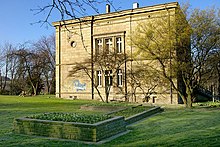
theatre
The Abrakadabra dance theater has its own venues, the Ruhrbühne Witten since 1999 - an amateur theater founded in 1926 - the Frohsinn theater community , an amateur stage that has been playing since 1921, and the Stockumer Theater Association , which theater enthusiasts Witten founded in 1993. There are also two touring theaters with children's and experimental pieces: the Witten children's and youth theater and the ensemble theater-spiel . In the hall building two cultural rings organize regular classical theater performances and concerts.
music
In addition to studying instruments and singing, the municipal music school also offers performances by various orchestras and ensembles. The Rhein-Ruhr-Philharmonie is a non-professional symphony orchestra with two annual concert phases. Other amateur ensembles are the Witten Bach Choir (founded in 1919), the Witten Mandolin and Guitar Orchestra , which has existed since 1929, and the Witten "BloW" Symphonic Wind Orchestra .
The Witten Days Festival for New Chamber Music invites you every year in April to contemporary music, sound art and music theater. The following bands have their home in Witten : Franz K. , who have dedicated themselves to blues and German rock since they were founded in 1969 , the rappers from Sons of Gastarbeita , Creutzfeld & Jakob , who do hip-hop , and the gothic metal band Eisheilig .
Public concerts take place regularly in the concert hall of the Protestant Pop Academy.
movie theater
The Burgkino Witten GmbH operates a movie theater with four halls of 250, 145, 85 and 30 seats. The Witten Film Club presents film art in the Werk ° Stadt and in Haus Witten.
Associations and Centers
In the hall structure is Wittener cultural community to find. The Education & Culture Initiative shows contemporary art and culture projects. The Stellwerk studio - an association of photographers, artists and culture managers - also runs the Knut’s culture pub . Despite everything , the independent socio-cultural center is Witten and houses the Gustav Landauer Library in Witten . Since 1977 the youth and cultural center Werk ° Stadt has been dedicated to "culture for everyone" and the youth café Treff ° is also located there. Students from the University of Witten / Herdecke run the Unikat university club .
Museums
The Märkisches Museum for contemporary art shows the collection of the city of Witten on German painting and graphics from 1900 to the present. The museum is located in the city center.
In the hoist museum / winch forge in the Heven district, a private exhibition by JD Neuhaus Hebezeuge GmbH & Co., you can see the winch forge and numerous historical machines as well as a replica of a Lübeck crane from the 14th century.
The Diakoniewerk Ruhr museum shows medical devices from the past 100 years.
The mine and field railway museum is located on the site of the former Theresia colliery . It is open every first and third Sunday of the month from April to October. In addition to viewing numerous exhibits from colliery railways, it also offers the opportunity to take a light railroad. The operated route leads from the hikers' car park on Nachtigallstraße across the grounds of the Theresia colliery to the Nachtigall colliery. The former Nachtigall colliery is one of eight locations of the LWL industrial museum . Here you have the opportunity to visit the colliery by the bucket, a historic barge, the colliery's machine house and a ring furnace (in which bricks or bricks were burned). Both museums are located in the Bommern district.
In the former miners 'prayer house in Muttental , the permanent exhibition “From the prayer house to coal” documents the miners' everyday life. The Muttental mining trail leads past here to the Herberholz colliery in Muttental. The “Friends of Mining Historic Sites” has a museum of mining equipment, tools and machinery here in the house and on the outside area.
Germany's largest exhibition of Shona sculptures from Zimbabwe is located in the garden of Steinhausen Castle.
Attractions
Art in public space
See: List of works of art in public space in Witten
Downtown
The Witten house was built as a mansion for a manor and is now home to the city's cultural center and a trendy bar.
The towers of the Johanniskirche from 1752, the oldest church in the city, and the neighboring town hall from 1926 form the symbol of the city.
The Roman Catholic St. Mary's Church was built from 1846 to 1848 and considerably expanded from 1894 to 1896, from 1872 to 1891 it housed the Old Catholic community.
The village-like cultural center of Witten WERK ° STADT was built in the former factory hall of a branch of the Mannesmannröhren-Werke .
Justice Councilor Eduard Strohn built the Helenenturm in 1858 in honor of his late wife Helene Strohn, née. Lohmann, it only became the property of the city in 1909.
In the vicinity of the city center, the sister park invites you to linger.
The garden city of Crengeldanz , a largely preserved workers' settlement in the Bergisch style , was built in 1913. The former moated castle Haus Crengeldanz is nearby .
The drinking water educational trail run by Stadtwerke Witten shows the water treatment stations. Located on the site of a water extraction station between the Ruhr and the Ruhr dike, the nature trail can be viewed after registering with the municipal utilities.
Bommern
Steinhausen Castle , originally a medieval castle complex with a manor house (reconstruction at the beginning of the 19th century) and castle park.
Herbede
In the nature reserve Hardenstein near the Nightingale mine is Burghard stone . Formerly a moated castle, the complex is now derelict.
Haus Herbede , a historic manor with four wings, serves as a meeting place and arts and crafts center with galleries. The medieval vaulted cellar is used as a restaurant. Thereis a memorialin Vormholz .
Anne
The Roman Catholic St. Joseph 's Church was built between 1903 and 1904, and on January 1, 1913, it was elevated to the status of an independent parish. The bell of the church consists of three bells from the bell and metal foundry Carl Munte . The E-tone bell has a weight of 920 kg and is dedicated to St. Joseph of Arimathäa . The G-tone bell weighs 525 kg and is consecrated to St. Boniface and the smallest, the A-tone bell, weighs 386 kg and is consecrated to St. Liborius . The two small bells are replacement pieces for their predecessors, which were melted down during World War II , and, in contrast to the large bell, are not made of bronze but of cast steel .
The Protestant Church of the Redeemer was built between 1872 and 1874 and has been a listed building since 1992 , its colored glazed windows are particularly worth seeing. The organ from 1968 sounds with 31 stops on three manuals and pedal.
The stone sculpture Marktfrau adorns the Annen market square .
The Carmelite nuns - monastery in Ardeygebirge is based in Witten in 1952 after the nuns after the Second World War from Wroclaw were expelled.
The Borbachschlösschen was built in 1867 and is located in the Borbach valley in Annen, above the Ruhr in the immediate vicinity of the Hohenstein. His discreet architecture is mainly due to the neo-Gothic pointed arch and the bay from Ruhr sandstone coined the historicist stucco ceilings and columns as well as the Art Nouveau - stained glass are worth seeing.
Surroundings
The Berger memorial on the Hohenstein is a 21-meter-high observation tower that offers a wide view of the Ruhr Valley's recreational area.
The Hohenstein hydropower plant, completed in 1925, is located in the Ruhr below the Hohenstein, it is a listed building and is part of the industrial heritage route .
The platform of the Kermelberg water tower , a landmark, can be climbed by visitors after consultation with the municipal utilities.
The nationally known mining trail Muttental leads through the district of Bommern and further, past numerous sights of the mining industry. The visible relics of mining and their history are explained on many display boards.
Railway enthusiasts can use the museum railway line of the Bochum-Dahlhausen Railway Museum , whose stops can be found in the districts south of the Ruhr.
Another destination is the Ruhr viaduct of the Witten-Hagen railway line and the largely disused Elbschetalbahn .
The Kemnader See is a popular local recreation area between the cities of Witten, Bochum and Hattingen .
Leisure time
Non-commercial offers
Over 150 km of marked hiking trails and five signposted, themed cycle routes in the city area offer sporty leisure activities. The Kemnader reservoir offers swimming and water sports; There are sunbathing areas around the lake. The meadow area between the lake and Haus Kemnade has become a meeting point for kite enthusiasts due to its excellent wind conditionsdeveloped. At the Imberg quarry , the youth meeting point in Annen, outdoor areas with a small hall and rock climbing can be used.
Commercial offers
Water tourism is offered by two excursion boats on the Ruhr and Kemnader See, on the latter there is a boat rental. The Ruhr valley can be explored with a museum train. The Berliner Platz offers the largest street cafe in downtown.
Sports clubs and facilities
In Witten there are 94 sports clubs with over 30,000 members, including the FSV Witten , KSV Witten 07 , the rowing club Witten , the Sport-Union Annen (SUA), the gymnastics community Witten and the rowing club Bochum von 1920 e. V.
Witten is traditionally a triathlon stronghold: both the Stadtwerke Witten and the PV-Triathlon Witten compete with a men's and a women's team in the 1st Triathlon Bundesliga .
Sports enthusiasts are 23 gyms, 14 playing fields, of which a stadium ( Smudge stadium ), six sports halls, two riding schools, three dance sports clubs and four dancing schools, eight shooting ranges, six tennis courts , three gymnasiums , a golf course , a disc golf -Parcour, a bowling alley , a Bowling center with several sports bowling clubs, a climbing garden (outdoor), four miniature golf courses , a beach volleyball hall , a sailing harbor, a leisure pool with indoor and outdoor pools and various saunas in Heven, two indoor pools in the districts of Annen and Vormholz, five teaching pools, two kendo clubs, A karate club, a public outdoor swimming pool in Annen and a club owned by the club in Rüdinghausen, a freerunning club, two motor sport clubs , two nudist clubs and a rugby pitch are available. There is also a wrestling performance center in Witten .
Regular events
The onion fair (traditional fair) takes place in downtown Witten every year on the 1st weekend in September . There is also the Ascension Fair , which takes place every year around Ascension Day (Thursday to Monday), and the Herbede Oktoberfest (street festival with live music, cabaret and handicrafts) on the 1st weekend in October in the Herbede district .
Every year on the middle weekend in June, the Kanu-Club Witten e. V. the Days of Thunder , a dragon boat event on the Ruhr just before the Kemnader reservoir. The Witten Dragon Boat Youth is nationally successful.
Furthermore, once a month, usually on the first Sunday of the month on the parking lot of a furniture store on the A 44, exit Witten-Annen, there is the Ostermann flea market , and every Tuesday from 6 a.m. on the Kemnader reservoir, parking lot Heveney, A 43, exit Witten- Heven has a children's flea market (semi-professional flea market with a focus on children's items of all kinds).
Telephone prefixes
While the telephone code 02302 applies in Witten, Buchholz has the code 02324 differently.
Personalities of the city of Witten
Philatelic
On July 2, 2020, the first day of issue, Deutsche Post AG issued a special postage stamp with a face value of 95 euro cents depicting the outdoor swimming pool in Witten-Annen in the series Germany from above . The design comes from the graphic artist Bettina Walter from Bonn, the photographer is Hans Blossey , who is known for such photos .
See also
- List of sacred buildings in the Ennepe-Ruhr district
- Witten murder
- Monument lists: architectural monuments , ground monuments , natural monuments
literature
history
- Heinrich Schoppmeyer : Witten. History of the village, town and suburbs . VOHM , Witten 2012, ISBN 978-3-00-040266-1 (2 volumes).
- Erich Keyser (Ed.): Westphalian City Book (= German City Book . Volume 3.2 ). Kohlhammer Verlag , Stuttgart 1954.
- Frank Ahland, Matthias Dudde (ed.): Wittener. Biographical portraits . tape 1 . Ruhrstadt Verlag, Witten 2000, ISBN 3-935382-02-2 .
- Frank Ahland, Stefan Nies, Ingrid Telsemeyer (eds.): Sprengstoff! The explosion of the Witten Roburit factory in 1906 . Klartext Verlag , Essen 2006, ISBN 3-89861-705-X .
- Walther Hubatsch (Ed.): Federal and Reich authorities (= The Protected Areas of the German Empire 1884–1920. Excerpts from the outline of German administrative history 1815–1945 . Volume 22 ). Johann Gottfried Herder Institute , Marburg 1984, ISBN 3-87969-183-5 .
- Rüdiger Jordan: Of capitals, pulpits and baptismal fonts. An exciting guide to 67 churches and monasteries in the Ruhr Valley . 1st edition. Klartext Verlag, Essen 2006, ISBN 3-89861-436-0 .
- Michael Schenk (Ed.): Witten. New pictures from the old days (= The archive pictures series ). Sutton Verlag , Erfurt 2009, ISBN 978-3-86680-409-8 .
- Bruno J. Sobotka : Witten on the Ruhr. From the past and the present . Edited by the Ostermann furniture store, Witten, 2nd edition. Krüger, Witten 2001, ISBN 3-9800852-2-8 .
- Ludger Tewes : Middle Ages in the Ruhr Area. Settlement on the Westphalian Hellweg between Essen and Dortmund (13th to 16th centuries). Verlag Schöningh, Paderborn 1997, ISBN 3-506-79152-4 .
- Wolfgang Zemter: Witten. From the old days . Meinerzhagener printing and publishing house, Meinerzhagen 1981.
Bibliographies
- Wolf-Dieter Lepiorz: Written in Witten. Bibliography from 1833 to the present day; Novels, short stories, dramas and poems . With a foreword by Hugo Ernst Buyer. 1st edition. Ruhrstadt Verlag, Witten 2002, ISBN 3-935382-08-1 .
- Wolf-Dieter Lepiorz: Bibliography of the city of Witten. Books and articles from magazines and compilations 1824–2002 . 1st edition. Klartext Verlag, Essen 2004, ISBN 3-89861-305-4 .
nature
- Nature Conservation Group Witten - Biological Station e. V. (Hrsg.): Nature between Ruhr and Ardey. Experience, understand and protect . 1st edition. Comedia, Bochum 2007, ISBN 978-3-00-020344-2 ( description [accessed on March 21, 2017]).
travel Guide
- Katja Link (Ed.): Witten. City guide . 1st edition. Link-Media-Verlag, Witten 2012, ISBN 978-3-940154-50-7 .
Web links
Individual evidence
- ↑ Population of the municipalities of North Rhine-Westphalia on December 31, 2019 - update of the population based on the census of May 9, 2011. State Office for Information and Technology North Rhine-Westphalia (IT.NRW), accessed on June 17, 2020 . ( Help on this )
- ↑ Stephanie Reekers: The regional development of the districts and communities of Westphalia 1817-1967 . Aschendorff, Münster Westfalen 1977, ISBN 3-402-05875-8 , p. 297 .
- ^ Federal Statistical Office (ed.): Historical municipality directory for the Federal Republic of Germany. Name, border and key number changes in municipalities, counties and administrative districts from May 27, 1970 to December 31, 1982 . W. Kohlhammer, Stuttgart / Mainz 1983, ISBN 3-17-003263-1 , p. 330 .
- ↑ Witten is officially allowed to call itself a “university town”. WAZ , December 6, 2015, accessed December 25, 2016 .
- ↑ Martina Kliner-Lintzen, Siegfried Pape: "... you can't forget that". Witten Jews under National Socialism . Ed .: City of Witten. Publishing house Dr. Dieter Winkler, Bochum 1991, ISBN 3-924517-44-4 .
- ↑ Claudia Scholz: "Circumcision does not traumatize". WAZ, September 25, 2012, accessed December 25, 2016 .
- ^ City of Witten Religion , 2011 census
- ↑ Beatrice Haddenhorst: plans approved. Renovation work: St. Marien becomes the administrative center. (No longer available online.) Ruhr Nachrichten , June 20, 2013, archived from the original on June 24, 2013 ; Retrieved June 20, 2013 .
- ↑ City of Witten 2019 , accessed on May 22, 2020
- ↑ Population of the municipalities of North Rhine-Westphalia on December 31, 2019 - update of the population based on the census of May 9, 2011. State Office for Information and Technology North Rhine-Westphalia (IT.NRW), accessed on June 17, 2020 . ( Help on this )
- ^ Result of municipal council elections Witten 2014. City of Witten, accessed on March 21, 2017 .
- ↑ CDU renegade takes over parliamentary group chairmanship at Witten Direkt. WAZ , June 5, 2014, accessed March 21, 2017 .
- ↑ Jürgen Augstein: SPD and CDU form “citizens' alliance” in the Witten Council. WAZ, June 12, 2014, accessed March 21, 2017 .
- ↑ Florian Groege: Witten ZOB. Traffic is rolling at the new bus station. Praise prevails. Ruhr Nachrichten , January 10, 2012, accessed on June 10, 2014 .
- ↑ Education & Culture Initiative. Retrieved June 1, 2012 .
- ↑ Knut's. Retrieved July 25, 2012 .
- ↑ Despite everything Witten. Retrieved April 27, 2017 .
- ↑ Werk ° stadt. Retrieved June 1, 2012 .
- ↑ Outdoor pool from above Westfalenspiegel July 2, 2020, accessed on July 24, 2020

